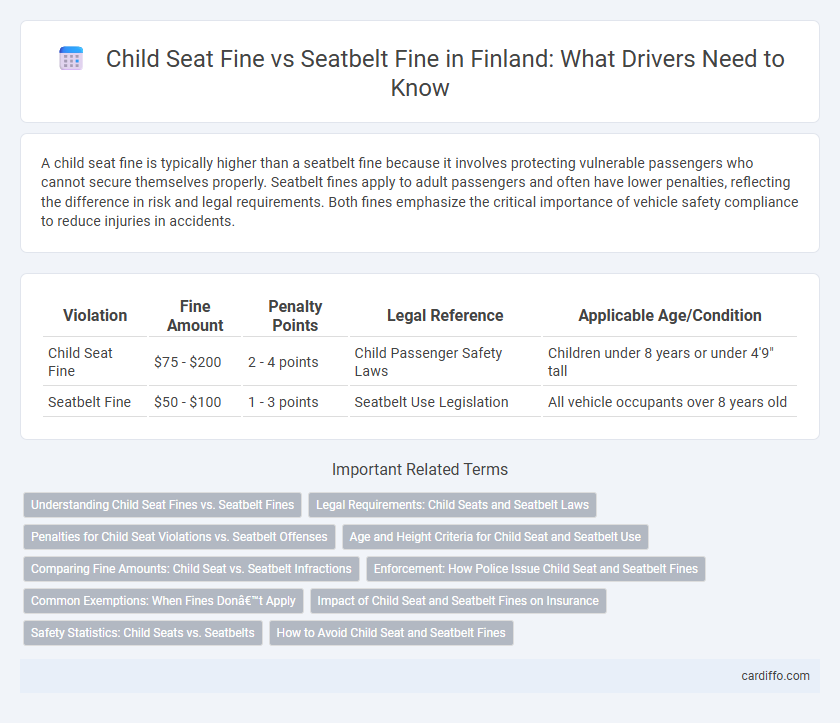A child seat fine is typically higher than a seatbelt fine because it involves protecting vulnerable passengers who cannot secure themselves properly. Seatbelt fines apply to adult passengers and often have lower penalties, reflecting the difference in risk and legal requirements. Both fines emphasize the critical importance of vehicle safety compliance to reduce injuries in accidents.
Table of Comparison
| Violation | Fine Amount | Penalty Points | Legal Reference | Applicable Age/Condition |
|---|---|---|---|---|
| Child Seat Fine | $75 - $200 | 2 - 4 points | Child Passenger Safety Laws | Children under 8 years or under 4'9" tall |
| Seatbelt Fine | $50 - $100 | 1 - 3 points | Seatbelt Use Legislation | All vehicle occupants over 8 years old |
Understanding Child Seat Fines vs. Seatbelt Fines
Child seat fines are typically higher than seatbelt fines due to the increased risk of injury to children in vehicle accidents. Laws mandate the use of age-appropriate and properly installed child safety seats to enhance protection, whereas seatbelt fines generally apply to passengers aged 13 and above. Understanding these distinctions helps ensure compliance with traffic regulations and promotes safer travel for all vehicle occupants.
Legal Requirements: Child Seats and Seatbelt Laws
Legal requirements for child seats are stricter and vary by age, weight, and height, mandating appropriate restraints for children under a specified age to ensure maximum safety. Seatbelt laws require all vehicle occupants over a certain age to wear seatbelts, with fines imposed for non-compliance. Penalties for child seat violations are typically higher to emphasize the importance of proper child restraint, reflecting increased legal responsibilities for drivers transporting minors.
Penalties for Child Seat Violations vs. Seatbelt Offenses
Penalties for child seat violations typically involve higher fines compared to seatbelt offenses due to the increased risk to child passengers. Child seat fines can range from $50 to $500, reflecting the critical safety importance and legal requirements for proper restraint use. Seatbelt offenses generally incur lower fines, often between $20 and $100, though repeat violations may result in escalated penalties and points on the driver's license.
Age and Height Criteria for Child Seat and Seatbelt Use
Children under 12 years old or shorter than 150 cm must use a child seat for optimal safety and legal compliance, with fines imposed for non-compliance varying by jurisdiction. Seatbelt fines apply primarily to occupants older than this threshold who are required to wear seatbelts regardless of seating position. Authorities emphasize strict adherence to age and height criteria to reduce injury risk and avoid penalties during traffic enforcement.
Comparing Fine Amounts: Child Seat vs. Seatbelt Infractions
Child seat fines typically exceed seatbelt fines due to heightened safety regulations protecting young passengers, with penalties ranging from $250 to $500 compared to $50 to $150 for seatbelt infractions. Enforcement agencies emphasize stricter fines for child seat violations to reduce fatalities and injuries among infants and toddlers, reflecting increased legal responsibility for caregivers. Comparing jurisdictional data reveals that child seat fines can be up to three times higher than seatbelt fines, reinforcing the critical importance of proper restraint use for children.
Enforcement: How Police Issue Child Seat and Seatbelt Fines
Police enforce child seat and seatbelt laws by conducting routine traffic stops and checkpoints, closely monitoring vehicle compliance with safety regulations. Child seat fines are often issued when drivers fail to use age- and size-appropriate restraints, whereas seatbelt fines target drivers and passengers who neglect to buckle up. Law enforcement officers rely on clear state guidelines to differentiate between the two violations, ensuring proper issuance and public safety adherence.
Common Exemptions: When Fines Don’t Apply
Common exemptions for child seat fines typically include situations where children have medical conditions that prevent the use of standard restraints or when using an approved alternative restraint recommended by a healthcare professional. Seatbelt fine exemptions often apply to drivers or passengers with disabilities who possess valid documentation allowing for such exceptions. Emergency situations, such as medical emergencies or when stopping briefly for safety reasons, may also exempt individuals from both child seat and seatbelt fines.
Impact of Child Seat and Seatbelt Fines on Insurance
Child seat and seatbelt fines significantly influence insurance premiums by reflecting the risk associated with non-compliance. Insurance companies often increase rates for drivers penalized for child seat or seatbelt violations due to the heightened potential for injury claims. Consistent adherence to child seat and seatbelt laws not only ensures safety but also helps maintain lower insurance costs through risk mitigation.
Safety Statistics: Child Seats vs. Seatbelts
Child seat fines reflect stricter enforcement due to statistics showing a 71% greater reduction in fatal injury risk for infants using child seats compared to seatbelts alone. Seatbelt fines are widespread, yet studies report that child restraints reduce injury risk for toddlers by 54%, highlighting their superior protective efficacy. Safety data consistently demonstrate that child seats provide enhanced crash protection, justifying higher penalties to ensure compliance and improve child passenger safety.
How to Avoid Child Seat and Seatbelt Fines
Ensure children are properly restrained using age-appropriate car seats or booster seats according to state regulations, as fines vary significantly but can reach hundreds of dollars. Regularly check local laws to stay updated on seatbelt and child seat requirements, including weight and height limits, to avoid penalties. Installing certified child restraints and consistently securing all passengers reduces the risk of fines and enhances road safety.
child seat fine vs seatbelt fine Infographic

 cardiffo.com
cardiffo.com